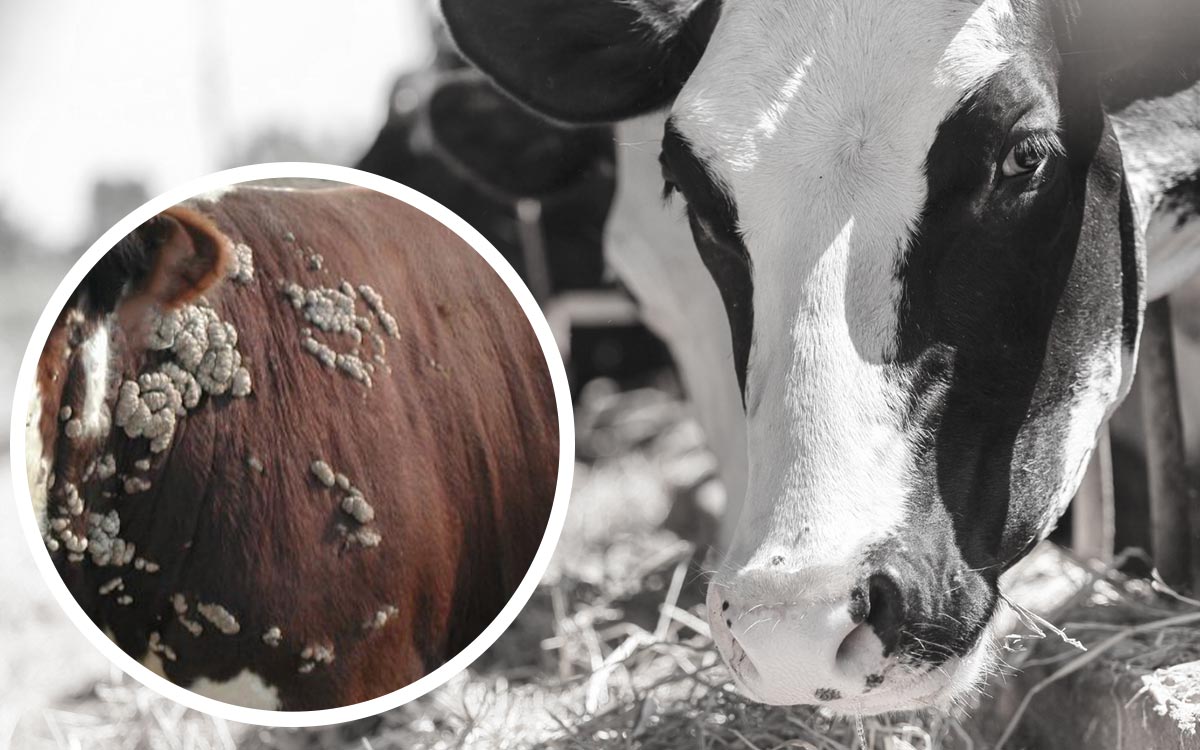External parasites can quickly wreak havoc on sheep flocks. According to the scientific journal, Parasites & Vectors, approximately 13 percent of sheep farms reported tick presence. Although tick-borne illnesses aren’t well-studied among sheep (as, say, cattle and domestic pets), we do know that ticks cause adverse health effects in sheep and can lead to significant economic impacts for farmers.
Sheep can get sick from tick bites. Tick-borne diseases that affect sheep include louping ill virus, tick paralysis, relapsing fever, cowdriosis (heartwater), anaplasmosis, and parasitic illnesses. Secondary complications include pyemia, skin and ear infections, wool destruction, and anemia.
This article discusses tick-borne diseases in sheep, as well as their diagnosis and treatment. Additionally, it covers potential secondary complications caused by these tick-borne illnesses in ruminants. Read on to learn more.
Tick-Borne Diseases in Sheep
There are hundreds of tick-borne diseases found in sheep. Farmers and veterinarians consider certain diseases more critical than others due to their significant economic impact. This section dives into eight tick-borne illnesses found in sheep, their geographical distribution, symptoms, diagnosis, and treatment options. We’ll also briefly touch on sheep and Lyme disease at the end of this section.
Louping Ill Virus (LIV)
Louping Ill Virus (LIV) is a tick-borne encephalitis flavivirus transmitted to sheep and other mammals via the bite of an infected tick.

In severe cases, death may occur within three days of symptom onset. Cases seem confined to Great Britain, primarily in Scotland, Ireland, and Wales.
Diagnosis typically depends on clinical manifestations (symptoms), although diagnosis may be confirmed using various tests, including the haemagglutination inhibition assay. In many cases, confirmations occur postmortem by isolating the virus from a specific bodily organ.
There are no effective treatments available for LIV, though sheep vaccines are available.
Tick Paralysis
This disease is exactly as it sounds — a progressive type of paralysis that starts at the lower part of a sheep’s body and ascends over time. Symptoms usually begin with poor muscle control, limb lameness, and breathing impairment before developing into full-blown paralysis.
Tick paralysis occurs in sheep due to salivary neurotoxins found in different species of ticks, including Dermacentor variabilis (American dog tick) and Dermacentor andersoni (Rocky Mountain wood tick).
Cases occur worldwide. In the United States, most cases happen in and around the Rocky Mountain states and the Pacific Northwest, though it is sometimes found in the American south.
Diagnosis of tick paralysis typically occurs in the presence of a tick on the sheep combined with clinical manifestations. Some ruminants experience rapid deterioration, so severe cases require prompt emergency veterinary care.
Treatment options include the removal of the tick (which may lead to considerable improvement) as well as antitoxin administration and/or antibiotics.
Tick-Borne Fever (Relapsing Fever)
Also known as relapsing fever, tick-borne fever is a bacterial disease transmitted by Ixodes ricinus (sheep tick). Rickettsia, the bacteria responsible for the illness, is often transmitted to mammals via ticks, lice, and fleas. In sheep, symptoms include sudden fever, depression, and weight loss.
Tick-borne fever occurs among sheep primarily in Europe, though there is a form of tick-borne fever in the United States caused by Borrelia hermsii that infects humans.
Diagnosis of tick-borne fever in sheep is usually made using a Polymerase Chain Reaction (PCR) test.
Treatment typically involves the administration of antibiotics, particularly oxytetracycline. This antibiotic has been approved by the FDA for use in sheep.
Babesiosis
Sheep may be infected by several species of Babesia, a type of parasite, but two particular species are more clinically significant concerning sheep.
Babesia motasi causes sheep babesiosis and is transmitted by tick species of the Haemaphysalis genus, including Haemaphysalis punctata, or the red sheep tick. Babesia ovis is transmitted by Rhipicephalus bursa, a multi-host tick.

It’s important to note that B. ovis regularly causes severe illness in sheep, with mortality rates as high as 50 percent.
Babesiosis infections are seen worldwide but are most common in tropical and subtropical regions. Cases are common in the Middle East, southern Europe, and some African and Asian countries.
Diagnosis of babesiosis usually involves light microscopy of blood smears.
Treatment options for sheep babesiosis include Imidocarb or diminazene aceturate. Imidocarb is considered the most effective treatment.
Theileriosis
There are several types of theileriosis parasitic infection among sheep, including:
- T. lestoquardi (transmitted by ticks of the genus Hyalomma)
- T. luwenshuni (transmitted by ticks of the genus Haemaphysalis)
- T. uilenbergi (transmitted by ticks of the genus Haemaphysalis)
In China, theileriosis is highly pathogenic, causing considerable health effects and disease among sheep flocks. T. uilenbergi, in particular, causes significant mortality in sheep. Sheep infected with theileriosis experience a multitude of symptoms, including:
- Persistent fever
- High heart rate
- Cough
- High respiratory rate
- Loss of appetite
- Slow-moving digestion (ruminal hypomotility)
- Enlarged lymph nodes
Most cases of theileriosis among ruminants occur across southern Europe, northern Africa, and various countries in Asia, rarely expanding outside of the tropical and subtropical regions.
Diagnosis involves microscopic observation of blood and lymph smears.
Treatment options include chemotherapeutic drugs, such as parvaquone, buparvaquone, and imidocarb. However, these pharmaceuticals rarely eradicate the parasite. As such, sheep with theileriosis may be treated but maintain a carrier status (meaning they’ll always have the parasite, though internal populations are controlled).
Cowdriosis (Heartwater)
Cowdriosis is a tick-borne disease commonly affecting sheep and other wild ruminants. Also known as heartwater, this illness is caused by the rickettsia bacteria Ehrlichia ruminantium. It is a non-contagious disease but may be transmitted to multiple animals via ticks (in the genus Amblyomma) and can infect cattle and goats.
Signs of heartwater tend to show up in sheep within a week to a month after an infected tick bite. Those symptoms include:
- Extreme fatigue
- Foaming at the mouth
- Sudden high fever (107°F+ or 41.6°C+)
- Depression
- Anorexia
- Repetitive chewing motions
- Breathing difficulties
- Hypermetric gait (high-stepping)
Most cases of heartwater are acute, though some lead to vascular damage.
Heartwater is widespread throughout much of the African continent. It occurs with some frequency on several Caribbean islands. Therefore, some diverse geographical strains may pose a threat to sheep in the United States. To date, however, no cases have been reported in America.
Diagnosis involves questions regarding symptoms and previous tick exposure. The condition is confirmed using blood smears to confirm the presence of rickettsia bacteria.
Treatment involves a long-lasting antibiotic, such as oxytetracycline. Administration should begin as soon as symptoms arise and diagnosis is confirmed.
Anaplasmosis
Anaplasmosis is yet another tick-borne bacterial illness (caused by Anaplasma phagocytophilum) that may affect sheep. These bacteria infect the red blood cells of the sheep, leading to several noticeable (and often severe) symptoms, including:
- Bloody diarrhea
- Emaciation
- High fever
- Jaundice
- Coughing
- Hemoglobin in urine (hemoglobinuria)
- Watery eyes
- Nasal discharge
- Wool loss
Anaplasmosis is seen worldwide, particularly in the northeastern United States, northern Europe, and southeast Asian countries.
Diagnosis involves microscopic observation of blood smears and serologic testing.
Treatment includes the administration of antibiotics, including tetracycline drugs. Early treatment is vital to increase survival rates.
Nairobi Sheep Disease (NSD)
Nairobi sheep disease (NSD) is one of the most pathogenic viruses of ruminants in Africa. It is a disease with extremely high mortality and has a significant economic impact.
Sheep suffering from NSD may experience severe symptoms, such as:
- Low white blood cell count
- High fever
- Sudden vomiting
- Bloody, foul-smelling diarrhea
- Rapid respiration and breathing difficulties
- Anorexia
- Depression
- Hypo-pyrexia (unusually low body temperature)
Reports of NSD occur mainly in eastern and central Africa, though there is another variant called Ganjam Virus that occurs in parts of Asia.
Diagnosis of Nairobi sheep disease typically involves microscopic plasma examinations. Many tests are performed postmortem and involve testing the lymph nodes and spleen.
There is no effective treatment for NSD. Eradication is considered virtually impossible once the virus has become well-established among the local tick population.
Do Sheep Get Lyme Disease?
Although sheep can contract Lyme disease from infected ticks, they do not experience systemic infection the way other mammals do. They do, however, still carry the disease, so they are capable of transmitting the illness to non-infected ticks. As such, sheep contribute to the spread of Lyme disease, so it’s important to control the tick population among your flock.

Secondary Problems Caused by Tick Bites
The disease is only one problem that affects sheep; there are several secondary problems that can lead to illness in your flock.
- Tick Pyemia – Young lambs (between two to 12 weeks old) may experience symptoms associated with a tick-induced blood infection (tick pyemia), leading to symptoms such as lameness and paralysis. Abscesses may appear on joints and internal organs. Death may occur as a result.
- Skin Issues and Wool Destruction – Tick infestations lead to extreme itchiness, which causes sheep to bite, scratch, and brush themselves against the ground, fences, barn walls, bushes, and even other animals. The constant rubbing can not only transmit ticks from one animal to another but may lead to skin irritation, open sores, wool destruction, bacterial skin infections, and tick-induced dermatophilosis. We recommend the use of the Intra Repiderma or Green Spray for optimizing healthy skin in sheep and lambs.
- Ear Infections – Heavy tick infestations frequently cause infections at the feeding site, including the ears. “Gotch” ear is a common occurrence caused by excessive tick bites. Regular tick feeding weakens the ear membranes, leading to droopy cartilage. It causes pain and irritation, and may increase the likelihood of recurrent ear infections (and reduces the value of the sheep).
- Anemia – Parasitic diseases transmitted by ticks (including babesiosis, anaplasmosis, and theileriosis) can cause anemia in sheep, leading to pale mucous membranes, blood loss, and extreme fatigue. In severe cases, it can lead to death.
Conclusion
Despite there being fewer studies on tick-borne illness concerning sheep, there is enough evidence to suggest that sheep are, in fact, adversely affected by ticks. Tick-borne diseases affect sheep worldwide and cause significant economic losses concerning wool, leather, milk, and meat. Focusing on preventative measures is the best way to keep your flock healthy.

Hoof Disease Reference Chart
Sources
- BioMed Central: Parasites & Vectors – Distribution and Prevalence of Ticks and Tick-Borne Disease on Sheep and Cattle Farms in Great Britain
- United States National Library of Medicine: General Review of Tick-Borne Diseases of Sheep and Goats Worldwide
- Science Direct: Louping Ill Virus
- Merck Veterinary Manual: Overview of Tick Paralysis
- Merck Veterinary Manual: Tick-Borne Fever in Ruminants
- Norwegian Institute of Public Health: Sheep Ticks and Tick Bites
- Merck Veterinary Manual: Babesiosis in Animals
- United States National Library of Medicine: Has The Red Sheep Tick, Haemaphysalis punctata, Recently Expanded Its Range in England?
- Merck Veterinary Manual: Theileriosis in Animals
- United States National Library of Medicine: Clinical and Cytological Characteristics and Prognostic Implications on Sheep and Goat Theileria Infection in North of Iran
- United States National Library of Medicine: Experimental Infection of North American Sheep with Ehrlichia ruminantium
- University of Florida: Emerging Pathogens Institute – Heartwater
- Merck Veterinary Manual: Anaplasmosis in Ruminants
- Merck Veterinary Manual: Nairobi Sheep Disease
- United States National Library of Medicine: Protecting Livestock Against Ticks in Pennsylvania
- United States National Library of Medicine: Natural Lyme Disease Cycles Maintained via Sheep by Co-Feeding Ticks
- Merck Veterinary Manual: Tick Pyemia in Lambs
- United States National Library of Medicine: Sheep and Goat Tick Management




